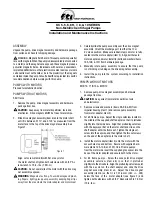
12 - English
OPERATION
WARNING:
Do not insert drill bit into chuck jaws and tighten as shown
in figure 17. This could cause drill bit to be thrown from
the drill press, resulting in possible serious personal injury
or damage to the chuck.
Tighten chuck jaws securely using chuck key provided.
Do not use a wrench to tighten or loosen chuck jaws.
Remove chuck key.
To remove the drill bit, reverse the steps listed above.
DRILLING
See Figure 18, page 20.
Using a clamping device, secure the workpiece to the
worktable. To protect the top surface of the workpiece,
use a piece of scrap wood between the vise and the
workpiece.
Select the proper drill bit based on the hole size desired.
For large holes, drill a pilot hole first, using a smaller
diameter bit.
Select and set the recommended spindle speed. Refer
to “Changing Speeds” in the
Adjustments
section of this
manual.
Set table assembly to desired height. Refer to “Adjusting
Table” Height
in the
Adjustments
section.
If desired, set feed shaft at desired spindle depth. Refer
to “Adjusting Depth Gauge”
in the
Adjustments
section.
Make sure the work table is free of all loose objects and
the bit is not in contact with the workpiece.
Plug electrical cord into power supply and turn switch
ON
. Make sure spindle rotates freely.
Slowly lower drill bit into workpiece. Do not force the bit;
let the drill press do the work.
Once the hole is completed, allow the spindle to return to
its normal position. This will automatically raise the chuck
and bit.
DRILLING TIPS
If a large hole is needed, it’s a good idea to drill a smaller
pilot hole before drilling the final one. Your hole will be
more accurately positioned, rounder, and the bits will last
longer.
If the hole is deeper than it is wide, back off occasionally
to clear the chips.
When drilling metal, lubricate the bit with oil to improve
drilling action and increase bit life.
As you increase the drill size, you may need to reduce
the spindle speed.
If drilling a through hole, make sure that the bit will not
drill into the table after moving through the workpiece.
Summary of Contents for DP103L
Page 50: ...NOTES NOTAS...
Page 51: ...NOTES NOTAS...













































